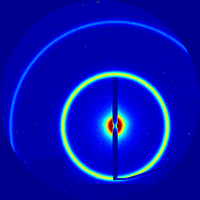Difference between revisions of "Scattering"
KevinYager (talk | contribs) (→TSAXS 3D) |
KevinYager (talk | contribs) (→TSAXS 3D) |
||
| Line 36: | Line 36: | ||
\end{alignat} | \end{alignat} | ||
</math> | </math> | ||
| − | where <math>\scriptstyle \alpha_f</math> is the out-of-plane component (angle w.r.t. to ''y''-axis, rotation about x-axis), and <math>\scriptstyle \theta_f </math> is the in-plane component (rotation about ''z''-axis). The total scattering angle <math>\scriptstyle 2 \theta </math> | + | where <math>\scriptstyle \alpha_f</math> is the out-of-plane component (angle w.r.t. to ''y''-axis, rotation about x-axis), and <math>\scriptstyle \theta_f </math> is the in-plane component (rotation about ''z''-axis). The total scattering angle <math>\scriptstyle 2 \theta = \Theta </math> is related via: |
| + | |||
| + | |||
| + | |||
| + | |||
| + | :<math> | ||
| + | \begin{alignat}{2} | ||
| + | q_x & = \frac{2 \pi}{\lamdbda} \\ | ||
| + | q_y & = \frac{2 \pi}{\lamdbda} \\ | ||
| + | q_z & = \frac{2 \pi}{\lamdbda} | ||
| + | \end{alignat} | ||
| + | </math> | ||
| + | And, of course: | ||
| + | :<math> | ||
| + | \begin{alignat}{2} | ||
| + | q & = \sqrt{ q_x^2 + q_y^2 + q_z^2 } | ||
| + | \end{alignat} | ||
| + | </math> | ||
==Theory== | ==Theory== | ||
Revision as of 16:05, 29 December 2015
Scattering broadly refers to experimental techniques that use the interaction between radiation and matter to elucidate structure. In x-ray scattering, a collimated x-ray beam is directed at a sample of interest. The incident x-rays scatter off of all the atoms/particles in the sample. Because of the wavelike nature of x-rays (which are simply high-energy photons; i.e. electromagnetic rays), the scattered waves interfere with one another, leading to constructive interference at some angles, but destructive interference at other angles. The end result is a pattern of scattered radiation (as a function of angle with respect to the direct beam) that encodes the microscopic, nanoscopic, and molecular-scale structure of the sample.
Contents
Geometry
TSAXS 1D
We define a vector in reciprocal-space as the difference between the incident and scattered x-ray beams. This new vector is the momentum transfer, denoted by q:
The length of this vector is:
Where is the scattering angle.
TSAXS 3D
The q-vector in fact has three components:
Consider that the x-ray beam points along +y, so that on the detector, the horizontal is x, and the vertical is z. We assume that the x-ray beam hits the flat 2D area detector at 90° at pixel position . The scattering angles are then:
where is the out-of-plane component (angle w.r.t. to y-axis, rotation about x-axis), and is the in-plane component (rotation about z-axis). The total scattering angle is related via:
- Failed to parse (MathML with SVG or PNG fallback (recommended for modern browsers and accessibility tools): Invalid response ("Math extension cannot connect to Restbase.") from server "https://wikimedia.org/api/rest_v1/":): {\displaystyle \begin{alignat}{2} q_x & = \frac{2 \pi}{\lamdbda} \\ q_y & = \frac{2 \pi}{\lamdbda} \\ q_z & = \frac{2 \pi}{\lamdbda} \end{alignat} }
And, of course:
Theory
The mathematical form of scattering is closely related to the Fourier transform. The sample's realspace density distribution is Fourier transformed into an abstract 3D reciprocal-space; scattering probes this inverse space. The fundamental equation in scattering is:
Where the observed scattering intensity (I) in the 3D reciprocal-space (q) is given by an ensemble average of the intensity for all (N) scattering entities probed by the beam. The wave-matter interaction is given by inner term, which coherently sums (interferes) the complex scattering contributions ( denotes the scattering power) of the N entities; the exponential term represents a plane wave (incident radiation). In integral form (for a continuous function of the scattering density ), we can write an integral over all of real-space:
The inner component can be thought of as the reciprocal-space:
This is mathematically identical to the (three-dimensional) Fourier transform.















